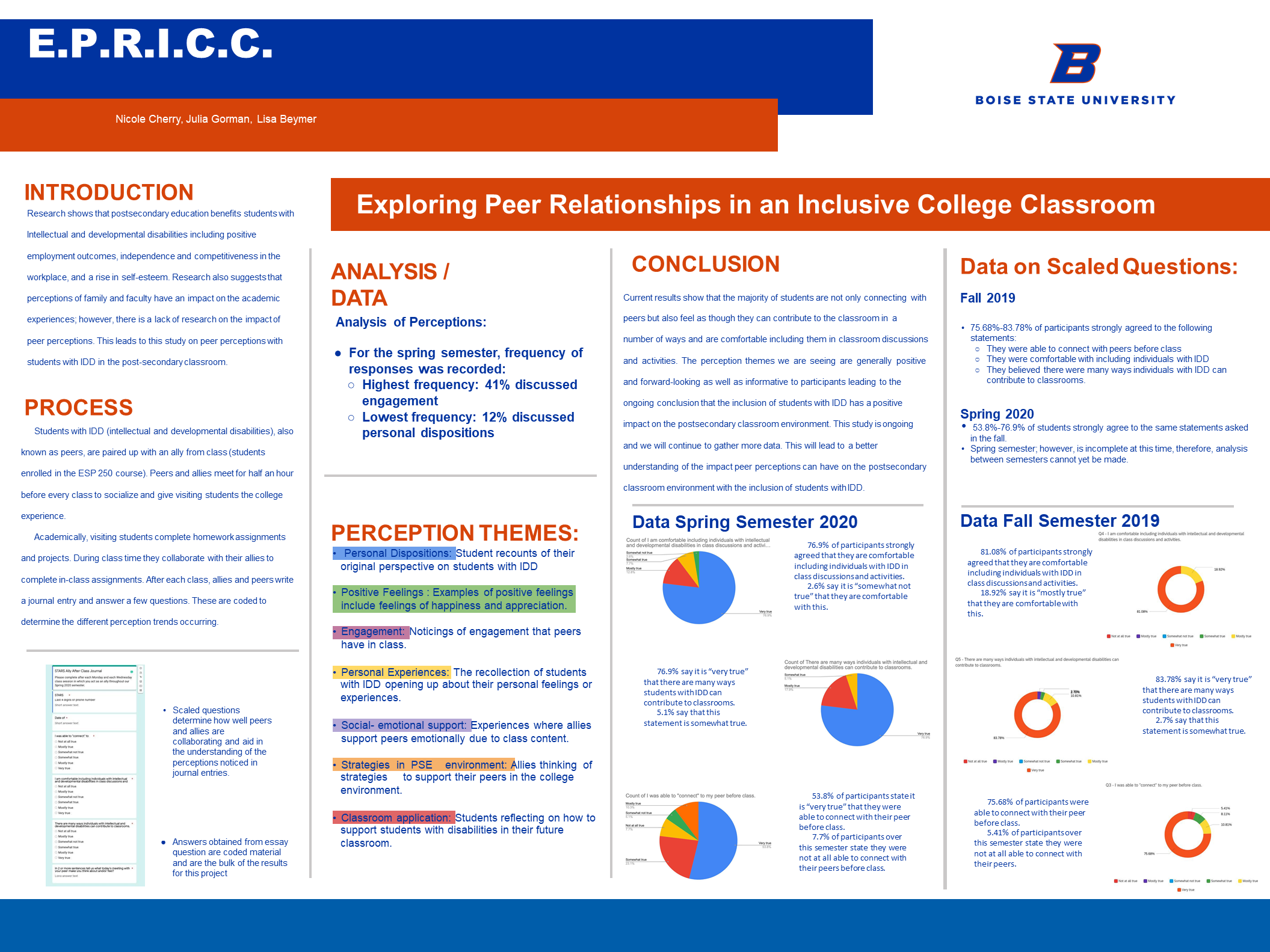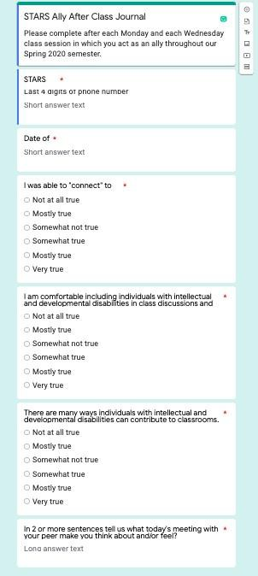Nicole Cherry, Julia Gorman, Dr. Lisa Beymer

Introduction
Research shows that postsecondary education benefits students with Intellectual and developmental disabilities including positive employment outcomes, independence and competitiveness in the
workplace, and a rise in self-esteem. Research also suggests that perceptions of family and faculty have an impact on the academic experiences; however, there is a lack of research on the impact of
peer perceptions. This leads to this study on peer perceptions with students with IDD in the post-secondary classroom.
Process
Students with IDD (intellectual and developmental disabilities), also known as peers, are paired up with an ally from class (students enrolled in the ESP 250 course). Peers and allies meet for half an hour before every class to socialize and give visiting students the college experience.

Academically, visiting students complete homework assignments and projects. During class time they collaborate with their allies to complete in-class assignments. After each class, allies and peers write
a journal entry and answer a few questions. These are coded to determine the different perception trends occurring.
- Scaled questions determine how well peers and allies are collaborating and aid in the understanding of the perceptions noticed in journal entries.
- Answers obtained from essay question are coded material and are the bulk of the results for this project
Analysis/Data
Analysis of Perceptions
For the spring semester, frequency of responses was recorded:
- Highest frequency: 41% discussed engagement
- Lowest frequency: 12% discussed personal dispositions
Perception of Themes
- Personal Dispositions: Student recounts of their original perspective on students with IDD
- Positive Feelings: Examples of positive feelings include feelings of happiness and appreciation.
- Engagement: Noticings of engagement that peers have in class.
- Personal Experiences: The recollection of students with IDD opening up about their personal feelings or experiences.
- Social- emotional support: Experiences where allies support peers emotionally due to class content.
- Strategies in PSE environment: Allies thinking of strategies to support their peers in the college
environment. - Classroom application: Students reflecting on how to support students with disabilities in their future
Data Fall Semester 2019
Comfort Level
- 76.9% of participants strongly agreed that they are comfortable including individuals with IDD in class discussions and activities.
- 2.6% say it is “somewhat not true” that they are comfortable with this.
Contributions
- 76.9% say it is “very true” that there are many ways students with IDD can contribute to classrooms.
- 5.1% say that this statement is somewhat true.
Connect with Peers
- 53.8% of participants state it is “very true” that they were able to connect with their peer before class.
- 7.7% of participants over this semester state they were not at all able to connect with their peers before class.
Data Spring Semester 2020
Comfort Level
- 81.08% of participants strongly agreed that they are comfortable including individuals with IDD in class discussions and activities.
- 18.92% say it is “mostly true” that they are comfortable with this.
Contributions
- 83.78% say it is “very true” that there are many ways students with IDD can contribute to classrooms.
- 2.7% say that this statement is somewhat true.
Connect with Peers
- 75.68% of participants were able to connect with their peer before class.
- 5.41% of participants over this semester state they were not at all able to connect with their peers.
Data on Scaled Questions
Fall 2019
75.68%-83.78% of participants strongly agreed to the following statements:
- They were able to connect with peers before class
- They were comfortable with including individuals with IDD
- They believed there were many ways individuals with IDD can contribute to classrooms.
Spring 2020
- 53.8%-76.9% of students strongly agree to the same statements asked in the fall.
- Spring semester; however, is incomplete at this time, therefore, analysis between semesters cannot yet be made.
Conclusion
Current results show that the majority of students are not only connecting with peers but also feel as though they can contribute to the classroom in a number of ways and are comfortable including them in classroom discussions and activities. The perception themes we are seeing are generally positive and forward-looking as well as informative to participants leading to the ongoing conclusion that the inclusion of students with IDD has a positive impact on the postsecondary classroom environment. This study is ongoing and we will continue to gather more data. This will lead to a better understanding of the impact peer perceptions can have on the postsecondary classroom environment with the inclusion of students with IDD.
Additional Information
For questions or comments about this research, contact Nicole Cherry at nicolecherry@u.boisestate.edu.